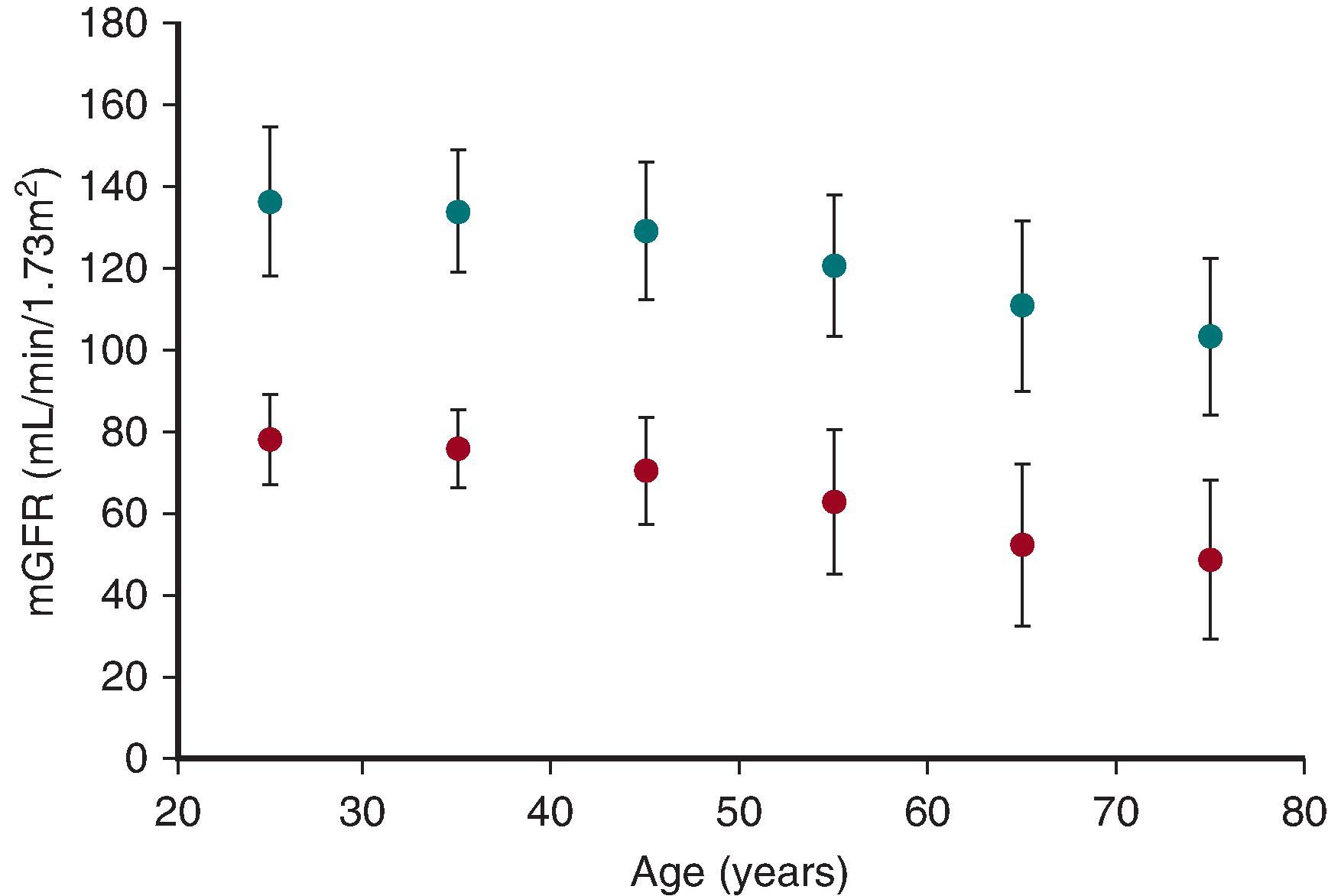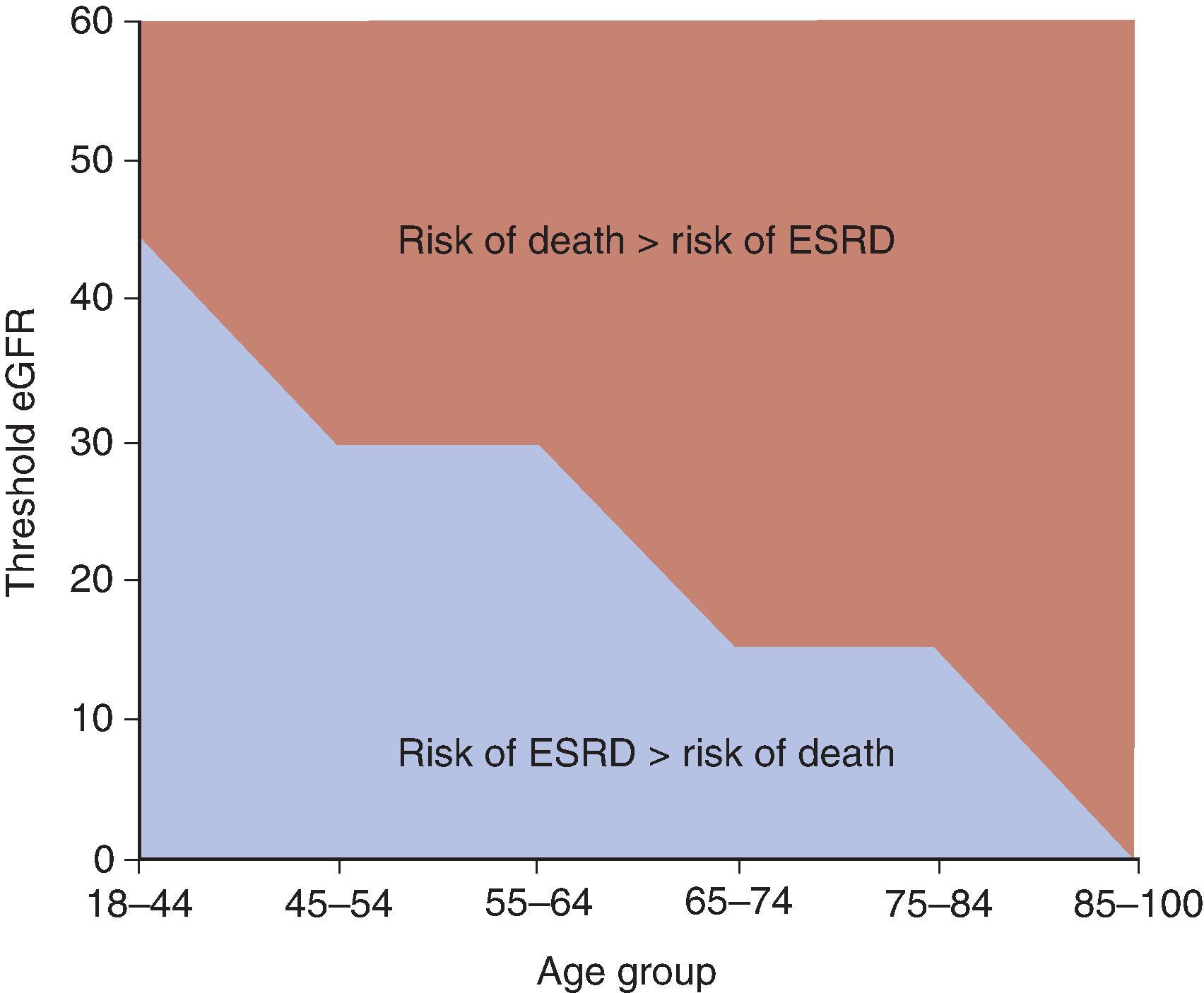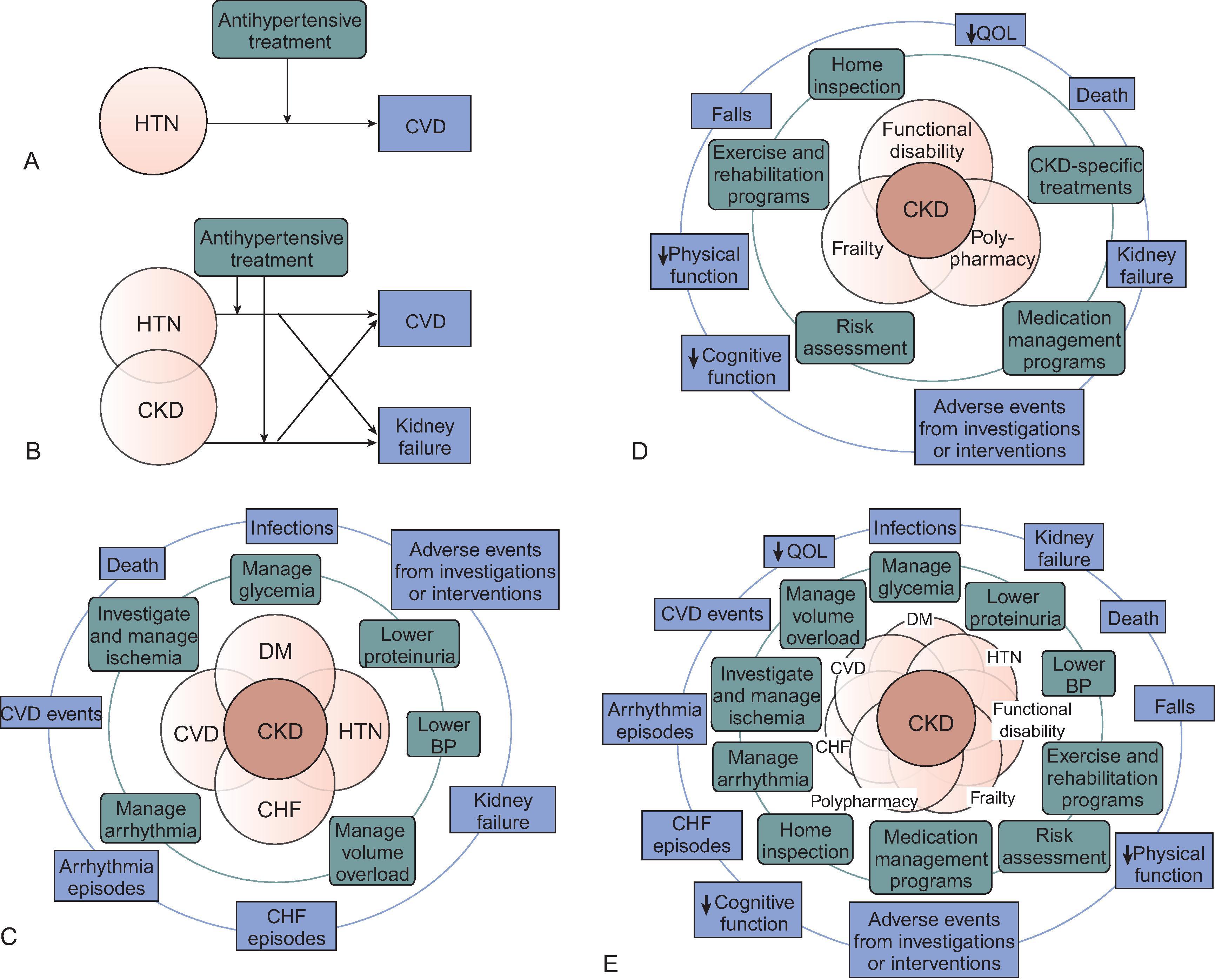Physical Address
304 North Cardinal St.
Dorchester Center, MA 02124
The prevalence of chronic kidney disease (CKD) increases markedly with age, and the number of older adults with advanced kidney disease will continue to increase as longevity improves due to medical advances and improved access to healthcare around the world. The prevalence of CKD increases from fewer than 6% in individuals less than 40 years old, to 44% among those age 70 and older. The high prevalence of CKD in older adults partially reflects structural and functional changes that occur in normally aging healthy adults and a higher prevalence of related comorbid conditions (e.g., diabetes and hypertension) at older ages.
Measured and estimated GFR in the general population follow a normal distribution with a median value around 80 to 90 mL/min/1.73 m 2 . The midpoint of this distribution decreases with age and moves closer to 60 mL/min/1.73 m 2 in some groups. A meta-analysis from published GFR measurements in more than 5000 healthy, Caucasian, potential living kidney donors calculated the expected decrease in mean measured and estimated GFR with age. This change was most pronounced in healthy women, in whom measured GFR decreased from 107 mL/min/1.73 m 2 in women aged 20 to 30 years old to 69 mL/min/1.73 m 2 in women over 70 years old. The upper and lower reference limits determined by the study show the anticipated decrease in eGFR by decade ( Fig. 48.1 ). In clinical practice this can roughly be estimated as a decline in eGFR of 0.5 to 1 mL/min/1.73 m 2 /year.

Urinary protein excretion also increases with age. However, the majority of older adults with CKD have an albumin-to-creatinine ratio (ACR) less than 30 mg/g, such that most older adults with CKD have low eGFR in the absence of significant albuminuria. This contrasts with younger adults with CKD, who are more likely to have albuminuria in the presence of a preserved eGFR ( Fig. 48.2 ).
![Fig. 48.2, Proportions of patients with chronic kidney disease identified by albumin-to-creatinine ratio (ACR), estimated glomerular filtration rate (eGFR), or both in the US population. (From James MT, Hemmelgarn BR, Tonelli M. Early recognition and prevention of chronic kidney disease. Lancet . 2010;375:1296–1309. Adapted from McCullough PA, Li S, Jurkovitz CT, et al. CKD and cardiovascular disease in screened high-risk volunteer and general populations: the Kidney Early Evaluation Program [KEEP] and National Health and Nutrition Examination Survey [NHANES] 1999–2004. Am J Kidney Dis . 2008;51:S38–S45.) Fig. 48.2, Proportions of patients with chronic kidney disease identified by albumin-to-creatinine ratio (ACR), estimated glomerular filtration rate (eGFR), or both in the US population. (From James MT, Hemmelgarn BR, Tonelli M. Early recognition and prevention of chronic kidney disease. Lancet . 2010;375:1296–1309. Adapted from McCullough PA, Li S, Jurkovitz CT, et al. CKD and cardiovascular disease in screened high-risk volunteer and general populations: the Kidney Early Evaluation Program [KEEP] and National Health and Nutrition Examination Survey [NHANES] 1999–2004. Am J Kidney Dis . 2008;51:S38–S45.)](https://storage.googleapis.com/dl.dentistrykey.com/clinical/ManagementofKidneyDiseaseintheElderly/1_3s20B9780323791229000480.jpg)
Prevalence estimates for CKD in older adults vary widely depending on the method used to estimate GFR (see Chapter 3). This specifically affects many elderly patients with eGFR values around 60 mL/min/1.73 m 2 , the threshold used to define CKD. The serum creatinine-based Chronic Kidney Disease Epidemiology Collaboration (CKD-EPI) equation for estimating GFR more accurately estimates GFR in patients older than 65 years of age with eGFR in the 60-89 mL/min/1.73 m 2 range than the MDRD equation. Newer equations have been developed from populations with a higher representation of older adults and may yield more accurate estimates of CKD. However, due to the substantial variation in the age composition of different clinical practices, equations validated only in elderly populations, such as the Berlin Initiative Study (BIS1), have not yet been incorporated into routine clinical practice. This may have little clinical impact: Comparisons between the CKD-EPI equation and the BIS1 equation did not show substantial differences from measured GFR values in older adults and the accuracy of estimates of GFR from either equation is likely sufficient to support most clinical decision making.
Non-creatinine-based methods to estimate GFR include formulas that utilize serum cystatin C and β2-microglobulin measurements. Their use was previously limited because these measures are more expensive with a slower turnaround time than serum creatinine. Serum cystatin C in particular is now more readily available and affordable. Ultimately, reliance on more than one filtration marker may be useful when trying to decide whether an older adult meets criteria for CKD, particularly among patients with underlying conditions or characteristics that may influence serum creatinine levels independent of kidney function, such as extremes of muscle mass, prior amputation, and vegetarian diets.
There is ongoing debate regarding the clinical significance of CKD in older adults because death due to cardiovascular causes is far more common than progression to kidney failure among most older adults who meet criteria for CKD, particularly those with mildly to moderately reduced eGFR (45–59 mL/min/1.73 m 2 ). At lower levels of eGFR the risk of kidney failure eventually exceeds the risk of death for most patient groups, but the threshold level of eGFR at which this transition occurs varies systematically by age ( Fig. 48.3 ).

Although an eGFR below 45 mL/min/1.73 m 2 is associated with poor outcomes, several studies have demonstrated that, unlike younger adults, those age 65 and older with mild reductions in eGFR in the 50–59 mL/min/1.73 m 2 range do not have a significantly higher risk of death compared to their age peers with GFR above 60 mL/min/1.73 m 2 . These studies highlight both the measurement issues discussed above and clinical uncertainty about the implications of such modest reductions in eGFR in older adults. The complex relationships among mortality, age, and GFR are likely modified by the presence of other factors including comorbid conditions and socio-demographic differences.
There also are systematic differences in the most common causes of CKD in older versus younger adults. In autopsy studies, arteriolar sclerosis, global glomerulosclerosis, renal artery stenosis, cholesterol embolization, and tubular atrophy were more common at older ages. While it remains unclear if nephrosclerosis and vascular disease are a normal part of aging, these likely contribute to progression of kidney disease in older adults.
Although the age-adjusted incidence of end-stage kidney disease (ESKD) in the United States has declined slightly since 2010, the prevalence of chronic kidney failure continues to rise. The high prevalence of maintenance dialysis at older ages is likely multifactorial, reflecting the high prevalence of CKD in older adults, increased life expectancy with advances in contemporary medicine, and improvements in dialysis care.
Despite the higher prevalence of CKD in the elderly, older adults more often do not need to start dialysis for kidney failure compared to younger patients with similar levels of kidney function. This is likely due to multiple factors, including greater competing risk of death, slower progression of CKD, and lesser uptake of kidney replacement therapy in older adults. To help predict the risk of kidney failure treated with dialysis, several scores have been developed including the VA risk score by Drawz and colleagues as well as the Kidney Failure Risk Equation. Both models have been widely validated, provide relatively accurate probabilities of requiring maintenance dialysis over 1-5 years, and appear to perform well in older adults with CKD. These scores can be readily incorporated into clinical practice to support discussions with patients and families about prognosis and individualizing care plans. Despite the lower predicted risk of requiring dialysis when compared to younger individuals with similar eGFR, the importance of general advanced care planning should not, however, be downplayed in this population with more comorbid conditions.
In older adults, the presence of multiple comorbid conditions may generate competing health priorities, conflicting treatment recommendations, and polypharmacy ( Fig. 48.4 ). Clinical practice guidelines rarely acknowledge the possibility that a patient may have more than one condition, nor do they distinguish between patients of different ages. Consequently, many clinical practice guidelines fail to provide guidance on how to manage the multiple competing health priorities that commonly arise in older adults with complex comorbidities. One study modeled the implications of a disease-specific approach to care on a hypothetical older adult with a fairly standard set of comorbid conditions. The onerous pharmacologic and non-pharmacologic treatment regimens that would have been recommended based on existing guidelines for each individual would have resulted in multiple potential drug interactions and competing treatment priorities.

Become a Clinical Tree membership for Full access and enjoy Unlimited articles
If you are a member. Log in here